Write the formula for the refraction of light on a spherical surface. Establish lens formula with its help. Symbols used their usual meanings.
Important Questions on Refraction, Dispersion and Lens
A light ray enters a solid glass sphere of refractive index at an angle of incidence . The ray is both reflected and refracted at the farther surface of the sphere. The angle (in degrees) between the reflected and refracted rays at this surface is:
A beaker of radius is filled with water up to a height as shown in the figure on the left. The beaker is kept on a horizontal table rotating with angular speed . This makes the water surface curved so that the difference in the height of water level at the centre and at the circumference of the beaker is , as shown in the figure on the right. Take this surface to be approximately spherical with a radius of curvature Which of the following is/are correct? ( is the acceleration due to gravity)
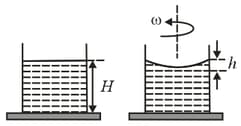
A transparent thin film of uniform thickness and refractive index is coated on the convex spherical surface of radius R at one end of a long solid glass cylinder of refractive index , as shown in the figure. Rays of light parallel to the axis of the cylinder traversing through the film from air to glass get focused at distance f1 from the film, while rays of light traversing from glass to air get focused at distance f2 from the film. Then
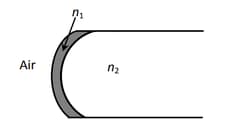
A parallel beam of light strikes a piece of transparent glass having cross section as shown in the figure below. Correct shape of the emergent wavefront will be (figures are schematic and not drawn to scale)


Two thin lenses are in contact with each other. One of these is a concave lens of focal length and the other is a convex lens of the same focal length. Determine the focal length of the combination and state how it behaves.
The word is written on board and viewed through different lenses such that board is at a distance beyond the focal length of the lens.
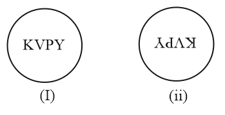
Ignoring magnification effects, consider the following statements.
Image has been viewed from the planar side of a plano-convex lens and image
from the convex side of a plano-convex lens.
Image has been viewed from the concave side of a plano-concave lens and image from the convex side of a plano-convex lens.
Image has been viewed from the concave side of a plano-concave lens and image from the planar side of a plano-convex lens. Image has been viewed from the planar side of a plano-concave lens and image from the convex side of a plano-convex lens.
Which of the above statements are correct?
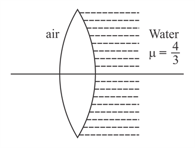
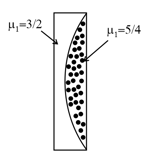
How many images are formed by the lens shown, if an object is kept on its axis?

Which of the following quantities related to a lens depend on the wavelength or wavelengths of the incident light?
A convex lens is in contact with concave lens. The magnitude of the ratio of their focal length is 2/3. Their equivalent focal length is 30 cm. What are their individual focal lengths?

